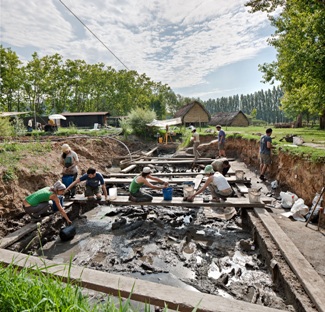Art and History

Obtaining Wood in Banyoles Area during the Neolithic
Two UAB researchers have studied the remains of charred wood recovered from the site of La Draga (Banyoles), occupied during the period 5300-5000 B.C., to discover the use of environmental resources of the first farming communities in the peninsular NE. The results allowed them to determine the existence of a riparian forest around Lake Banyoles and a deciduous forest in the rest of the area. The timber resource management strategy had been determined by the accessibility and abundance of species, as well as by the properties of the wood.
References
Caruso Ferme, Laura; Piqué i Huerta, Raquel. Landscape and forest exploitation at the ancient Neolithic site of La Draga (Banyoles, Spain). The Holocene. 2014. doi: 10.1177/0959683613517400.
The site of La Draga is locatedon the eastern shore of Lake Banyoles (Girona, northeastern Spain), at 172 m above sea level. Part of the site is covered by the waters of this karst lake, which currently has acircumference of about 8 km, while the levels of the site found on land are partially within the water table. This has enabled excellent conservation of organic matter, and it is the only lacustrine site known in the Iberian Peninsula. The site corresponds to an open air settlement of the first farming communities in NE Iberia, and has a surface area of about 8000m2, of which 784m2 have been excavated. This area belongs to an open-air settlement, occupied from 5300-5000 B.C., by one of the first agricultural communities documented in the area. Two habitation periods have been determined; the more ancient is characterized by wooden constructions, while the more recent one incorporated travertine as a construction material.
The study Firewood and Forest Exploitation at the Ancient Neolithic Site of La Draga has as its objective the evaluation of how the first agricultural communities of the NE peninsular exploited the resources in their environment. Based on the analysis of thousands of carbonized wooden remains found in the deposit it is possible to determine the characteristics of the natural landscape in which the firewood was gathered.
The study has determined that in the vicinities of Lake Banyoles, around 7300 years ago, there was an ample gallery forest of laurels, willows, poplars, lambruscas, elms and alders while the temperate deciduous forest, dominated by oak trees, occupied the rest of the landscape. Probably factors such as accessibility of the resources, abundance in the environment and properties of the wood were the main criteria in the design of wood resource management strategies for energy production. While it has been determined that a minimum of 18 woody species were collected and consumed from the riverside communities and temperate forests, three of them were particularly exploited: the oak tree (deciduous species of Quercus), laurel tree (Laurus nobilis), and boxwood (Buxus sempervirens). Boxwood is more presently found in the second phase of occupation, which may be related to a greater availability of this species, possible as a result of the manipulation of the environment.
Laura Caruso Fermé
Raquel Piqué i Huerta
Department of Prehistory
2025 Universitat Autònoma de Barcelona
B.11870-2012 ISSN: 2014-6388
